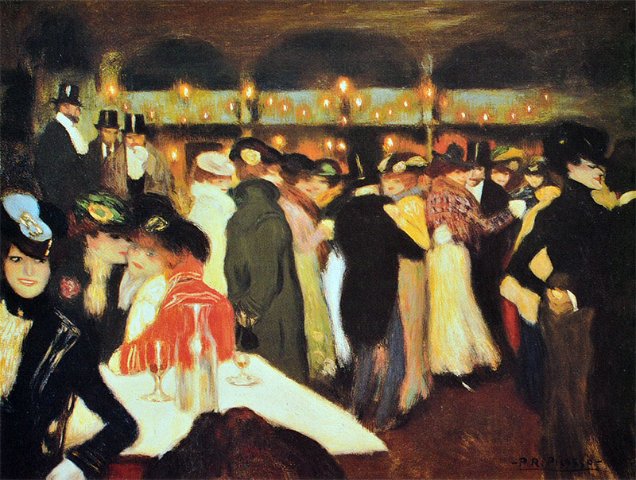Young Picasso in Paris
Solomon R. Guggenheim Museum
By: Guggenheim - May 12, 2023
Young Picasso in Paris
Solomon R. Guggenheim Museum, 1071 Fifth Avenue, New York
May 12–August 6, 2023
The Guggenheim Museum presents Young Picasso in Paris, an intimate exhibition comprising a total of ten paintings and works on paper executed during Pablo Picasso’s introduction to the French capital. Created over the course of one pivotal year, these works explore a critical juncture in his artistic development, as Picasso encountered novel contemporary subjects and styles.
Picasso (b. 1881, Málaga, Spain; d. 1973, Mougins, France) arrived in Paris from Barcelona in autumn 1900, during the final weeks of the Exposition Universelle that included his 1898 painting Last Moments in the Spanish pavilion.
The ville lumière, or city of lights, captivated, and ultimately transformed, the nineteen-year-old Spaniard. He absorbed much of what Paris had to offer over his initial two-month stay and during his return the following May through the end of 1901. Picasso patronized not only the art galleries, but also the bohemian cafés, raucous nightclubs, and sensational dance halls in the hilltop neighborhood of Montmartre.
Coinciding with the fiftieth anniversary of Picasso’s death, Young Picasso in Paris highlights a significant work, Le Moulin de la Galette (ca. November 1900), from the Guggenheim collection. The famous dance hall—formerly a mill engaged in the production of a brown bread, or galette—had also been depicted by such avant-gardists as Ramón Casas, Pierre-Auguste Renoir, Henri de Toulouse-Lautrec, and Vincent van Gogh. In his titillating version, Picasso rendered a vibrant cross section of Paris society mingling under the dance hall’s lights.
One of his first paintings executed in Paris, Le Moulin de la Galette was also recently the subject of an extensive conservation research and treatment project at the Guggenheim. Findings of analytical work and imaging, conducted in collaboration with the Metropolitan Museum of Art, New York, and the National Gallery of Art, Washington, D.C., informed the removal of accumulated surface dirt and a nonoriginal, discolored varnish.
The treatment unveiled previously obscured subtleties in Picasso’s painting, including the brushwork, colorful palette, and spatial definition. Furthermore, technical imaging revealed that at an earlier stage Le Moulin de la Galette included a lapdog seated on a chair in front of the table at the bottom left of the painting. As the final composition evolved, Picasso hastily covered the dog with strokes of brown paint, leaving the contour of its head evident and allowing hints of the underlying colors to show through. Picasso directed more attention toward the figures and the space by eliminating the canine. Nevertheless, he left visible clues of the compositional change, which would become a frequent practice for the artist.
The young Picasso was fascinated with unconventional aspects of modern life, finding inspiration in the sites of social gathering where divisions of gender and class were circumvented and in the people who attended them. All told, his forays into Paris left a strong impression; he would settle there in 1904. An emerging artist in 1900, Picasso eventually surpassed his academic training to forge a singular practice reflective of his time.
Young Picasso in Paris is organized by Megan Fontanella, Curator, Modern Art and Provenance. Conservation research and treatment of Picasso’s Le Moulin de la Galette were conducted by Julie Barten, Senior Painting Conservator and Associate Director of Conservation Affairs.
Support for Young Picasso in Paris has generously been provided by Almine Rech and Bernard Ruiz-Picasso, Acquavella Galleries, Helena and Per Skarstedt, Judy and Leonard Lauder, The Ronald and Jo Carole Lauder Foundation, Linda Lindenbaum, and Audrey and David Mirvish.
Additional funding is provided by the Solomon R. Guggenheim Museum’s Patrons Circle.
Scientific analysis of Le Moulin de la Galette was conducted in collaboration with the Network Initiative for Conservation Science (NICS), a Metropolitan Museum of Art program. Support for NICS was provided by grants from the Mellon Foundation and the Sloan Foundation.
Young Picasso in Paris is organized by the Solomon R. Guggenheim Museum with the special support of the Musée national Picasso-Paris.
2023 marks the fiftieth anniversary of Pablo Picasso’s death and thus is devoted to the celebration of his work in France, Spain, and internationally. To celebrate Picasso’s legacy today is to question what this major work of Western modernity represents today; it is to show its living, accessible, and current part.
The Picasso Celebration 1973–2023 was initiated by the Musée national Picasso-Paris, the main lender of the event and its coordinator, and Bernard Ruiz-Picasso, grandson of the artist and president of the Fundación Almine y Bernard Ruiz-Picasso para el Arte (FABA) and the Museo Picasso Málaga. It is structured around some fifty exhibitions and events that will be held in renowned cultural institutions in Europe and North America and which, together, thanks to new interpretations and approaches, will make it possible to review the current state of studies and understanding of Picasso’s work.
The French and Spanish governments have decided to work together on this major transnational event, and thus the commemoration will be punctuated by official celebrations in France and Spain and will end with a major international symposium in autumn 2023, at the time of the opening of the Centre d’Études Picasso à Paris.
It is the theme of “Picasso today” that embodies this celebration and which lays the foundations for the Musée national Picasso-Paris of tomorrow.


